A digital adoption strategy will help you identify how you want to use technology within your organization and how you want to interact with your customers. This will allow you to create an effective plan for using new technologies and integrating them into your existing processes.
You can use a digital adoption strategy to increase your businesses capacity for growth and to ensure that your employees are using the digital tools you’ve provided and are getting the best use out of them.
This article will cover how to create a digital adoption strategy, what pitfalls to avoid while doing so, and how you can get the most out of your digital adoption efforts.
Creating A Digital Adoption Strategy: The First Steps

The first step in creating a digital adoption strategy is understanding where you are now and where you want to go. You should look at your current situation and see if there are areas where you need to improve. For example, if you have a website but no social media presence, then this could be an area where you need to focus some attention.
Once you know where you are, you can start thinking about where you want to be. What do you want your organization to look like in five years? How does that compare to where you are now? You might need to invest in new equipment or software to become more competitive. However, if you just want to keep up with the competition, you may not need to spend much money.
Once you understand where you are now, you can start thinking through how you want to get from here to there. Do you want to change everything all at once? Or would you prefer to implement changes over a period of time gradually? Some businesses choose to slowly introduce new technologies, while others jump straight in and try to catch up quickly.
Adding new technology or methodology to your workflow will disrupt your daily operations and increase digital transformation initiatives. On top of that, each staff member will have differing knowledge and skills when it comes to using these types of technology.
Your aim should be not to give each employee the same amount of training but to get them all to the same skill level when using the new technology. Your existing digital assets might not be used to their fullest extent, whether because of inexperience or because your personnel is used to doing things another way.
Overall, developing key digital adoption strategies is about maximizing the usefulness of your technology. There are times when doing things digitally makes sense and when pen and paper are more efficient. Ultimately, it’s up to you to draw the line.
- How Do Digital Adoption Platforms (DAPs) Enhance Digital Adoption Strategies?
- 10 Tips To Get The Most Out Of Your Digital Adoption Strategy
- 6 Factors That Affect & Obstruct Digital Adoption
- Why Is Digital Adoption Important?
- The 14 Pillars Of A Foolproof Digital Adoption Strategy
- Digital Adoption Strategy Considerations
How Do Digital Adoption Platforms (DAPs) Enhance Digital Adoption Strategies?

DAPs (digital adoption platforms) provide a comprehensive set of features that allow organizations to manage all aspects of digital transformation, from strategy development to execution. They include content creation, marketing automation, customer engagement, social media management, analytics, mobile apps, and many others. DAPs are designed to work together seamlessly, so they can be deployed across multiple channels and devices.
Digital adoption strategies are often developed by teams responsible for different parts of the business. These teams may include IT, marketing, sales, operations, finance, HR, etc. Each team has its own responsibilities, which means that each one needs to be involved in developing their part of the strategy.
It’s important to remember that these teams aren’t working against each other. Instead, they are working together to achieve common goals. The best way to ensure everyone is happy with the final product is to involve them early in the process.
If you’re looking to develop a digital adoption strategy, we recommend starting with the following steps:
10 Tips To Get The Most Out Of Your Digital Adoption Strategy
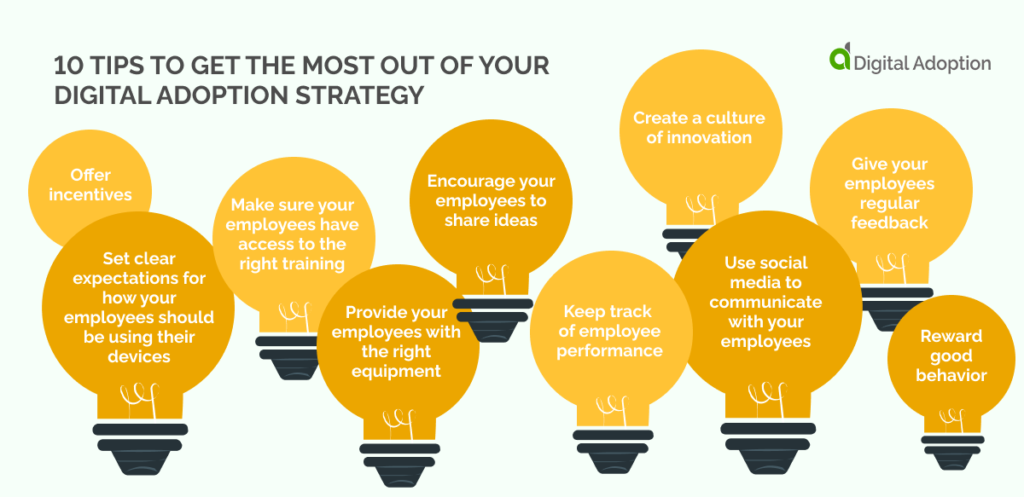
The following tips will help you ensure your business is taking advantage of all the benefits of technology and ensuring that your staff can get the most from it.
1. Set clear expectations for how your employees should be using their devices
It can be easy to assume that everyone in an organization has a smartphone or tablet, but this isn’t always the case.
If you want to ensure that your employees are making the most of their digital adoption efforts, then you need to set clear expectations about how employees should use them.
This means creating policies around acceptable usages, such as limiting time spent online during working hours and setting rules around which apps can be accessed at work.
2. Make sure your employees have access to the right training
If you don’t know where to start, then providing practical employee training is probably your best bet. For example, if you’re looking to provide your staff with enhanced IT skills, you could look into using a DAP with in-app guidance to assist your employees in learning new processes.
3. Provide your employees with the right equipment
Providing your employees with the right hardware is essential to helping them do their jobs effectively. For example, having the right software installed on their computers can mean that they can easily access important documents and information.
4. Encourage your employees to share ideas
Encouraging your employees to share ideas and suggestions can go a long way towards improving efficiency and maintaining employee retention within your company.
By encouraging your team members to talk through problems and come up with solutions together, you’ll be able to find ways to improve processes and streamline workflow.
5. Keep track of employee performance
You might think keeping track of employee performance would be challenging, but it doesn’t have to be.
You can use many methods to keep tabs on your employees productivity and performance. One method is to create a simple spreadsheet that lists each task completed by every team member.
6. Offer incentives
Incentives are great motivators for people who aren’t naturally motivated. Offering rewards to employees who complete tasks efficiently can encourage them to continue doing so.
7. Use social media to communicate with your employees
Social media platforms like Facebook and Twitter are perfect for communicating with your employees. They allow you to send messages directly to your workers and will enable you to update them on any changes happening within your company.
8. Create a culture of innovation
A culture of innovation encourages your employees to try new things and experiment with new technologies. To achieve this, you need to make sure that your employees feel comfortable trying new things without fear of being reprimanded.
9. Give your employees regular feedback
Regular feedback from managers and supervisors helps to identify areas of improvement and allows your employees to grow professionally.
10. Reward good behavior
Rewarding positive behaviors will encourage your employees to continue behaving positively. It also makes them more likely to follow your instructions and adhere to company policy.
6 Factors That Affect & Obstruct Digital Adoption

Poor digital adoption is more common than you might think. Successful digital transformation starts with assessing current adoption rates and measuring how they affect business outcomes. We’ve compiled a list to help you understand the most common digital adoption challenges.
1. Inability to set realistic targets
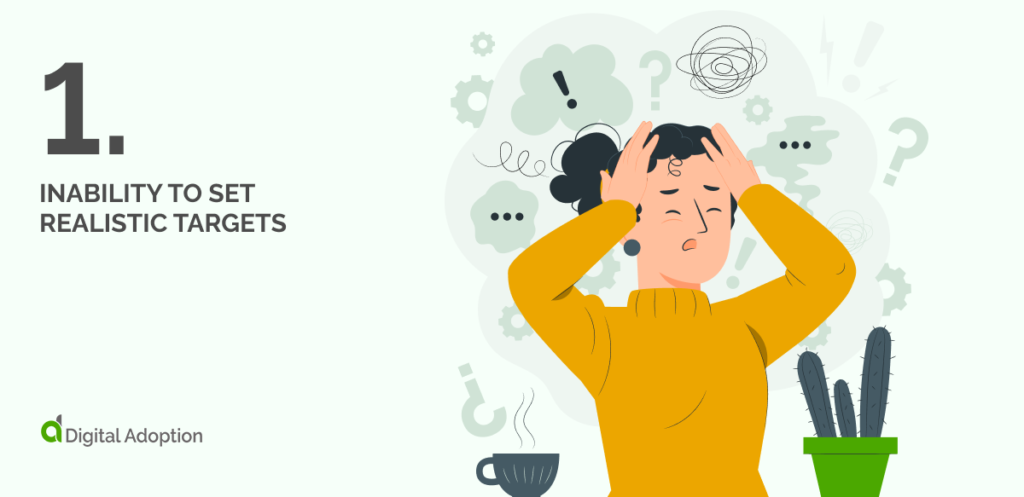
When you start planning your targets, you might be tempted to assume a best-case scenario.
That will never be the case, as hiccups and roadblocks will crop up at every opportunity. There’s also the fact that what one person can do in an hour might take another three, etc.
Setting targets need to assume that there will be delays. It must be assumed that not everyone will get up to scratch as fast as possible, whether because of off days or misunderstandings.
2. Lack of collaboration
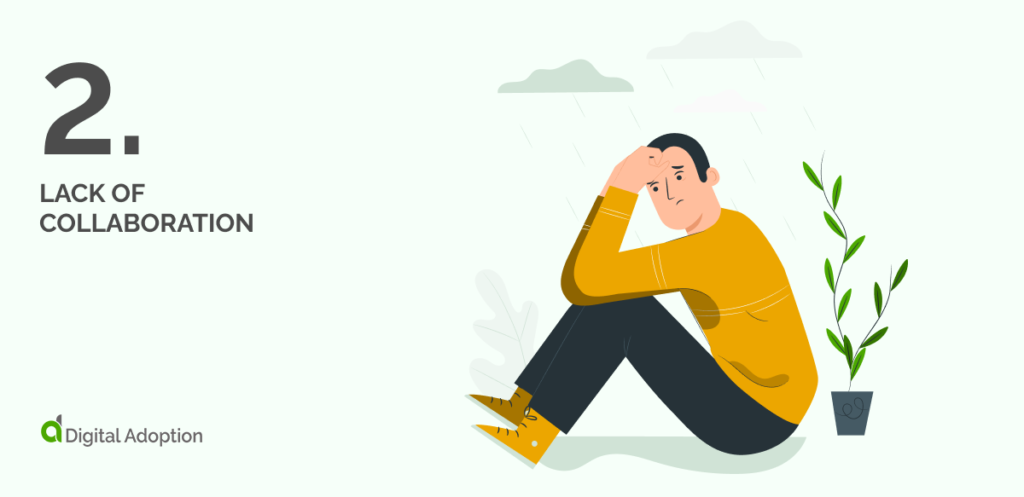
Learning can be cooperative. This is especially true when dealing with a new technology with which team members might have different experience levels.
These team members will get up to speed faster than everyone else, but that’s not all they can do for you. If you have team members with prior experience with the piece of technology in question, utilize them!
Collaborative learning, where the team learns together, is much faster than each individual trying to get acquainted with the technology independently.
Errors will be repeated less, lessons one person learned can be passed on to another, etc.
3. Poor communication
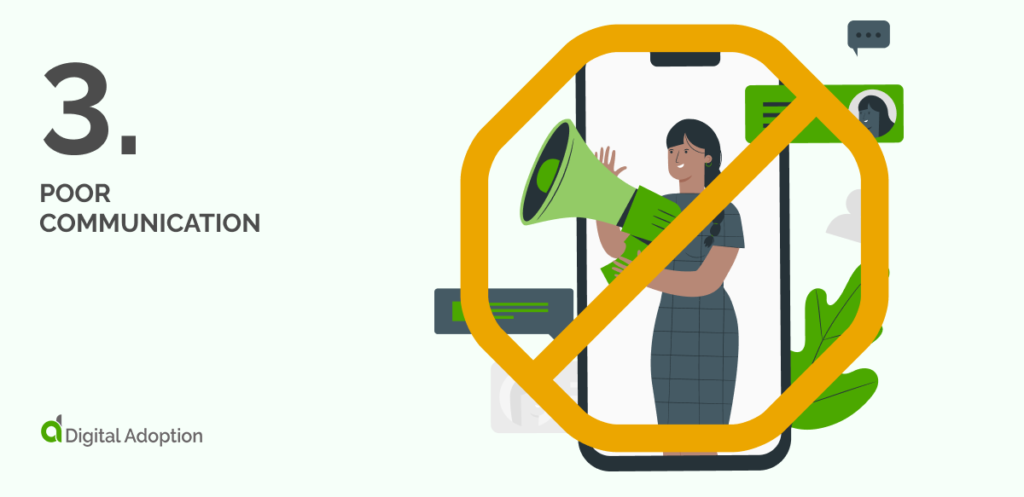
New technology is daunting to any workforce. You’re bound to encounter resistance to change, difficulties using new pieces of technology, and even outright refusals to use the new methods if you fail to communicate.
Communication is key to digital adoption. By keeping your team informed of what you’re doing, but more importantly, why you are doing it, you can get them on board and enthusiastic about helping implement the digital adoption process rather than being obstacles to it.
This is especially true when you’re thinking about what you want to use the new technology for and the methods needed. Changing how things are done will annoy your team members; however, if they know why the changes are being made, they’re much more likely to go along with said changes than resist them.
4. Failure to measure goals
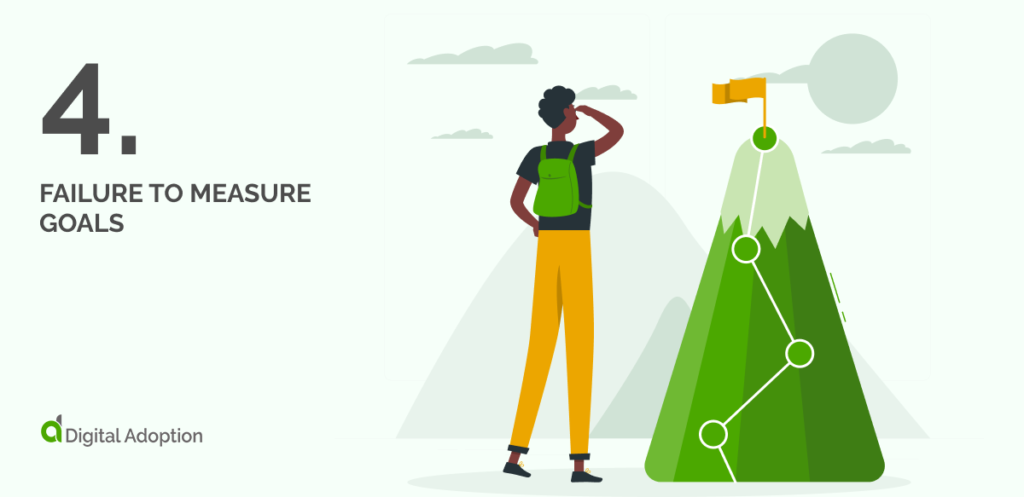
When you’re implementing a new piece of technology into your business, you need to think about what it is you want to achieve with that technology. Do you want to speed up a workflow? Cut time spent on manual calculations or data entry? Technology should be implemented for a reason, not just because you can; setting goals is a part of that.
During the digital adoption process, you might think to focus on proficiency with a new piece of software, assuming that it will translate directly into increased efficiency.
This isn’t strictly true since some parts of the software will be entirely useless to your methods. You need to focus on the parts that will be of use, making sure that your team is proficient in those parts, with the rest not mattering in the short term.
5. Long time to training

When you add new technology, you must also add training for it. That’s something that’s not negotiable unless your employees already have proficiency in that technology. Technology driven organizations should introduce new and updating training sessions wherever possible to stay ahead of the latest industry trends.
Every day that a member of your team spends using technology they’re unfamiliar with is an unproductive day, and the longer this goes on, the more productivity you will have wasted. Ultimately, training should come directly after or during the implementation process if you want to keep on track and continue your workflows at the same or an improved pace.
There will always be a decrease in productivity while the team gets to grips with the new technology. That’s not something you can change, but how long that decrease lasts is something you can.
6. Lack of feedback
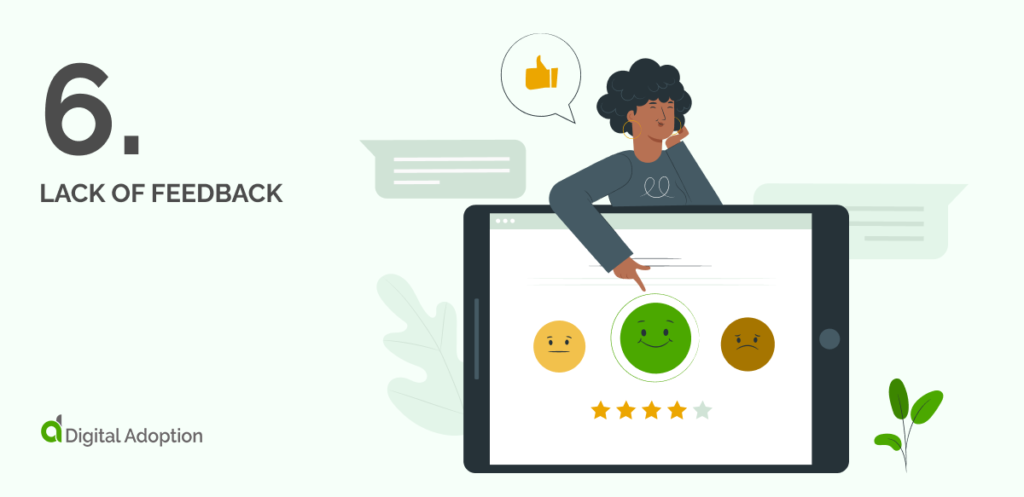
No matter how clearly you communicate your vision to your employees, misunderstandings and mistakes will always occur.
The former is worse than the latter since the person in question will carry on using the technology in a way that doesn’t align with your vision, thinking it is correct. Feedback can solve this. It’s the best way to inform your team how they’re performing and what can be done to improve.
This is especially important to consider when using new technology, as they might have no frame of reference for what is considered correct. By keeping them informed, you cut mistakes and increase overall efficiency.
Why Is Digital Adoption Important?
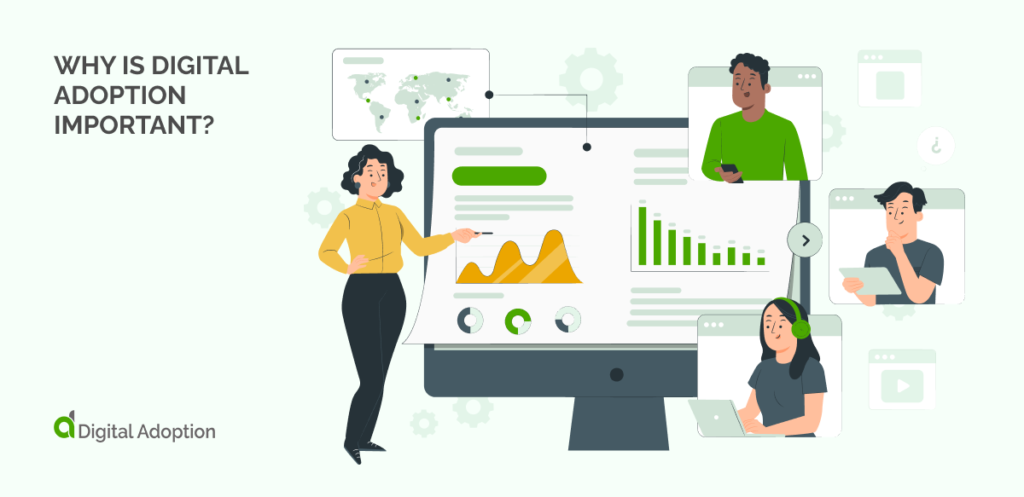
Adopting technology to the fullest extent enables businesses to measure digital adoption rates so that you get a better return on investment (ROI) on the digital assets you purchase.
Not only that, but it can increase the efficiency of your operations, making things less taxing on your workforce and more attractive to your customers. Faster operations and speedier problem solving are very important, especially to younger generations who often emphasize time over price.
The key facet that digital adoption embodies is usability. In other words, it is using the technology you’ve bought rather than having it sit on the side waiting to be needed. Some business owners make the mistake of thinking that the newest and shiniest technology is the best when in reality, it might not be suited to your organization.
Digital adoption means using technology to its fullest and examining where it might help you improve.
The 14 Pillars Of A Foolproof Digital Adoption Strategy

1. Adequate leadership vision
Successful digital adoption is a top-down strategy. Your organization’s leaders, whether team leaders, managers, department heads, etc., need to know what you plan to achieve for it to come to fruition.
Those at the very top set the end goal of a digital adoption strategy. It may be up to the middle management to figure out how to make this happen, but at the end of the day, they will need guidance and understanding of what exactly it is you want to achieve to make it happen.
2. Understanding the current state
To plot a route from A to B, you need to know where both A and B are. This is the case also with digital transformation, with the current state of your organization needing to be examined before you can start plotting out a route to get you to your idealized outcome.
Information on your organization can come from many sources, but in the case of technology usage, it’s best to go directly to those who use the technology. You may have heard of the old adage, “in matters of boots, refer to the bootmaker.”
Those who will work directly with the technology you’re thinking of implementing will have a far better understanding of how it might benefit you than someone three stages removed, such as a departmental manager.
3. Defined cross-departmental responsibilities
Defining responsibilities before you implement your strategy allows you to avoid confusion in the later stages. Every department that the new piece of technology affects, whether directly through use or indirectly through its results, needs to have a clearly defined responsibility when it comes to implementing, testing, and analyzing the results of your implementation.
Digital adoption is a process that needs collaboration and communication to succeed. Your employees need to talk to their team leaders, who need to talk to each other and their managers, etc.
4. Dealing with resistance & cultural barriers
Nobody likes change. This is especially true when dealing with lower-level employees since many will simply go through the motions and not actually care about the business itself.
Whether intentional or not, you’ll encounter resistance to change from your personnel and should take steps to avoid it. There are also cultural factors at play. Some cultures are far more averse to adopting new technologies than others, for example, preferring verbal communication to any form of messaging software.
Not only will these personnel be slow to adapt to the new ways, but you may encounter active resistance rather than unintentional, and these need to be worked around.
5. Providing equal attention to ongoing training
The more attention you pay to proper training during the digital adoption process, the more likely it is to succeed.
Some organizations make the mistake of assuming that deploying your technology is the most important factor when in actuality, being able to use it affects the success of your strategy even more than the speed at which you deploy.
Training employees in using the new technology leads to less time wasted as they try to figure things out for themselves and less frustration and resentment from employees who would otherwise feel forgotten about during the process.
6. Staying on top of current and future trends
Technology is constantly advancing. No matter what sector you’re looking at, there’s bound to be new technology created that will be able to advance your organization’s capabilities. By keeping an eye on trends, you can identify which technologies are necessary upgrades, which would be nice to have, and which are entirely superfluous.
On the flip side, you need to be aware that not every new technology will become widespread. Plenty of tech startups fail, and if you’ve purchased software that will stop working once the startup goes under, that’s an investment wasted.
The key to keeping on top of technology is being open-minded but critical. Keep yourself open to suggestions from any staff member, but make sure to examine them critically before making a choice.
7. Poor data governance
There’s a state which is well known in software adoption called feature hell. Essentially, it’s when users of an application fail to understand how to utilize the software properly and end up trying to bypass the system itself to get the job done.
This is a terrible idea for a number of reasons. First off, skipping steps or filling them in with dummy data means any analysis drawn from that data later is worthless. Furthermore, if the user fails to understand how to use the application, any results they do end up with are suspect.
The best way around this is simply to use a digital adoption platform to keep your team up to scratch.
8. Ensuring best practices for collaboration
No department works in a vacuum. Digital transformation efforts must collaborate across teams and departments to keep business running as usual.
Is one department that uses results from another lagging behind? Ensure that the results provided are clear and simple to use.
Have two teams traditionally used the same database? Make sure the new application allows them to share data.
Collaboration is the heart of digital transformation, and you need to be aware of what each team or department does and how their use of the new technology could affect the others when creating your strategy.
9. Content delivery in multiple formats
Not everyone learns in the same way. Not everyone in your business will work in the same way either. Providing tailored learning formats to each individual or team’s needs ensures they learn how to use the new technology as quickly and efficiently as possible.
Content can be delivered through:
- PDFs
- Emails
- Videos
- Walkthroughs
- Lectures/Seminars
- LMS courses
Which one you pick for which department is ultimately up to your judgment, but ensuring multiple options are available dramatically increases your chances of a smooth adoption.
10. Pilot program analysis
Adding new technology to your workforce is bound to come up with unexpected issues that aren’t simple to solve. In order to minimize the overall impact these issues have on your organization, you should use a pilot program.
A pilot program is a small test of the new technology, performed by perhaps one team or department before full implementation. It’s essentially using this team as guinea pigs for your current strategy.
With a pilot program, you’ll see what issues might arise from the current strategy while having them only affect a small part of your organization and subsequently figure out how to solve them.
11. Post-deployment training & evaluation
Once a user has gotten to grips with the basics, it’s time to provide personalized online training and feedback that directly affects their role.
An individual’s role within your organization will determine what they will do with the new technology and what skills they need to learn.
By using workflows, department segregation, and other means, you can split your employees up by the role they will fulfill. You can then develop a standardized training program for each group, meaning that the knowledge they receive is relevant to their role.
12. Support/IT ticket reduction
When you go through any change in your business operations, you will end up with more support tickets.
New users will be flooding the support team with questions and problems that they’re having, resulting in the team becoming overwhelmed and unable to support everyone as fast as would be ideal.
The solution? Reduce the number of support tickets.
While that sounds like a nice idea, doing it requires careful consideration of the software to determine common issues and FAQs by creating a knowledge base upon which your users can draw. This will keep things running even when the support team is working on someone else’s problem.
13. Keep employees up to date with new processes
The more your organization changes, the higher the chance of some employees being left in the dust when learning how to cope with these changes.
It’s incredibly challenging to keep everyone up to date and avoid the constant interruptions to work that training sessions will inevitably cause. Employees should be encouraged to keep up with the changes. Ultimately, the responsibility is on the management to ensure that everyone is up to speed.
A digital adoption solution can help immensely by providing on-the-job training that eliminates the need for multiple training sessions. The data it collects can also be used to analyze performance and keep an eye on who needs support and, most importantly, why they need it.
14. Analyze, measure, improve and repeat
Any kind of transformation should be analyzed to check efficiency and effectiveness. Digital adoption strategies are no exception, with the outcome being measurable and therefore analyzable in most cases.
If your analysis shows that the adoption process is lacking, refine it!
Digital adoption isn’t a static process that needs to be followed to the letter. It’s an ongoing and flexible approach that molds to suit the organization, team, individual, etc. Analytic software can help you learn a great deal about what is going on in your organization and will draw your eye toward any issues that crop up so that you can tackle them promptly.
Digital Adoption Strategy Considerations
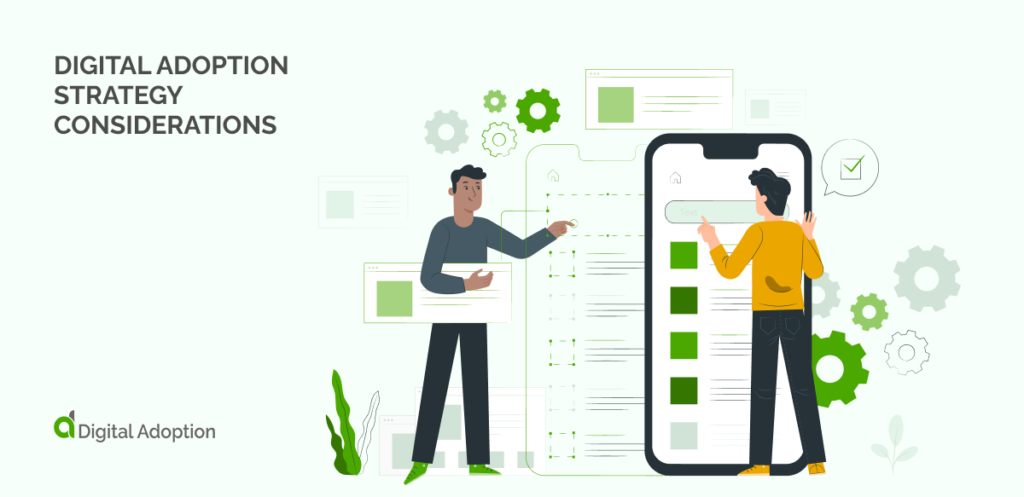
Digital adoption strategies need careful consideration and planning before any steps are implemented. The disruption that implementing new technology causes might mean it’s more of a hindrance than a help overall.
However, the benefits are clear to see once the strategy has been developed and implemented. Your company will become more efficient, effective, and productive, all while reducing costs and improving customer service.
You’ll have fewer support requests, less time spent dealing with them, and better results from each interaction. Your business will grow, your customers will love you, and your employees will thank you for making their lives easier.
So, if you want to ensure that your organization adopts digital technologies effectively, start developing a digital adoption strategy today. It could just be what you need to get ahead of the competition.









